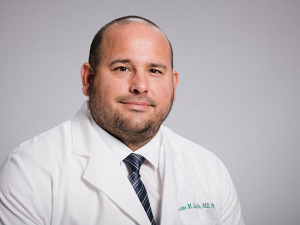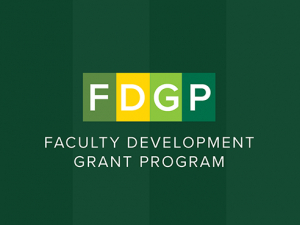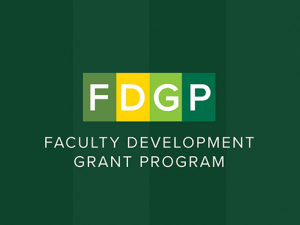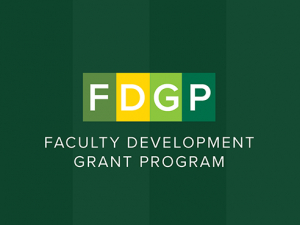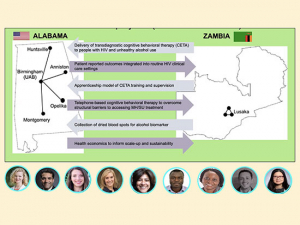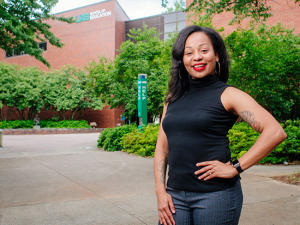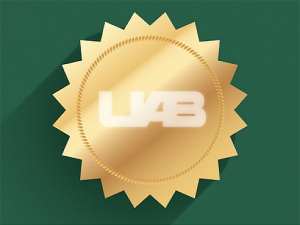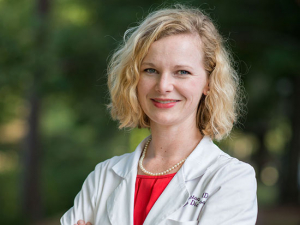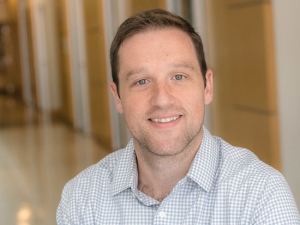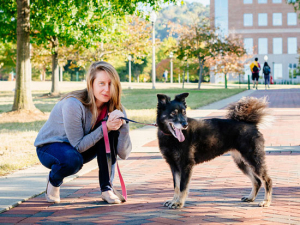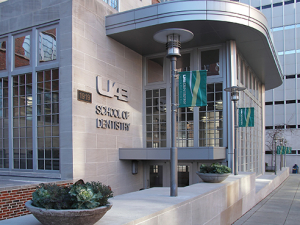 “I want to talk about Black language as an art form and not something to be eradicated,” said Teaira McMurtry, Ph.D., assistant professor in the Department of Curriculum and Instruction. With a Faculty Development Grant, McMurtry will do just that with Alabama K-12 teachers.There is a moment, one minute and 42 seconds into her dynamic TED Talk, when Jamila Lyiscott perfectly captures the essence of Black language.
“I want to talk about Black language as an art form and not something to be eradicated,” said Teaira McMurtry, Ph.D., assistant professor in the Department of Curriculum and Instruction. With a Faculty Development Grant, McMurtry will do just that with Alabama K-12 teachers.There is a moment, one minute and 42 seconds into her dynamic TED Talk, when Jamila Lyiscott perfectly captures the essence of Black language.
“I’m here to tell you that even our language has rules,” Lyiscott says. “So when Mommy mocks me and says ‘Y’all be madd going to the store.’ I say, ‘Mommy, no, that sentence is not following the law. Never does the word ‘madd’ go before a present participle. That’s simply the principle of this English.’”
What English? Which English? The same English that Teaira McMurtry, Ph.D., heard for six years as she taught literature in high schools in Milwaukee, Wisconsin, and the English that McMurtry spoke in her own home and with friends: Black English, also known as Black language, African American English and African American Vernacular English.
Rich, vibrant form of expression
McMurtry, an assistant professor in the UAB School of Education’s Department of Curriculum and Instruction, has known she wanted to be a teacher since she was a little girl. But it wasn’t until she was a senior in college that she learned there was such a thing as Black language — a rich, vibrant form of expression with a long history and a complex linguistic form.
A tiny section in a class on linguistics for teachers led McMurtry to a deep exploration of the language used by playwright August Wilson, novelists Zora Neale Hurston, Alice Walker and James Baldwin, and more recently, bestselling young adult author Jason Reynolds. “I said, ‘What is this?’” McMurtry recalled of discovering Black language. “This is how I speak. This is how my community speaks!”
“I said, ‘What is this?’” McMurtry recalled of discovering Black language. “This is how I speak. This is how my community speaks!”
Black language developed as “the creation of the Black diaspora,” as Baldwin said in a 1979 essay in the New York Times. “Blacks came to the United States chained to each other, but from different tribes. Neither could speak the other’s language.” So they developed a new language, combining the syntactic structure of standard American English with distinct patterns that have been traced to parallel West African languages. Habitual be, double/multiple negation, and optional third-person singular/possessive marker (-s), all part of Black language, are also features of Niger-Congo languages such as Wolof, Mandingo and Yoruba.
“Despite popular beliefs, decades of linguistic research affirm that AAE [African American English] is not ungrammatical, unsystemic and illogical,” McMurtry wrote in her doctoral dissertation. “AAE is just as grammatically and functionally complex as any other variety of American English.”
Story continues after box
Hear more from FDGP recipients
 Find out how to apply for the next round of Faculty Development Program Grants and watch McMurtry and four other faculty selected for this year's grants discuss their projects on the UAB Faculty site.
Find out how to apply for the next round of Faculty Development Program Grants and watch McMurtry and four other faculty selected for this year's grants discuss their projects on the UAB Faculty site.
A ‘communicative disconnection’
In her dissertation, McMurtry quotes this typical exchange between a teacher and student:
Teacher: Where is Mary?
Student: She not here.
Teacher (exasperatedly): She is never here[?]
Student: Yeah, she be here.
Teacher: Where? You just said she wasn’t here.
“There is a bi-directional communicative disconnection that is occurring here,” McMurtry writes. The student’s first response above demonstrates the third-person singular “s” deletion; the second demonstrates the habitual be (Mary is usually here, just not now). The teacher’s instinct, meanwhile, is to correct. But “the worst form of humiliation for students is public scrutiny or embarrassment in front of their peers,” McMurtry said. “It makes students shut down.”
“Despite popular beliefs, decades of linguistic research affirm that AAE [African American English] is not ungrammatical, unsystemic and illogical,” McMurtry wrote in her doctoral dissertation. “AAE is just as grammatically and functionally complex as any other variety of American English.”
This communicative disconnection could play a major role in the persistent achievement gap between Black and white students in K-12 schools, McMurtry argues. “Because pre- and in-service teachers may deem African American English to be sloppy speech, slang and broken standard English, they make comments to students like, ‘We don’t talk that way in here’ (Meier, 2009, p. 99), which consequently denigrates students’ home language,” McMurtry writes in her dissertation. This results in millions of conversations like the following:
Teacher: Bobby, what does your mother do every day? (the teacher wants to find the best time to call Bobby’s mother)
Bobby: She be at home.
Teacher: You mean, “She is at home.”
Bobby: No, she ain’t, ’cause she took my grandmother to the hospital this morning.
Teacher: You know what I meant. You are not supposed to say, “She be at home.” You are to say, “She is at home.”
Bobby: Why you trying to make me lie? She ain’t at home.
Toward responsive literacy instruction
“As teachers, we come to the classroom with the idea that we can make students the best they can be,” McMurtry said. “But some of the practices we see in the classroom go against what the research and theory show to be best for our students.”
As Toni Morrison once said in a 1981 interview, “It’s terrible to think that a child with five different present tenses comes to school to be faced with those books that are less than his own language. And then to be told things about his language, which is him, that are sometimes permanently damaging.”
“As teachers, we come to the classroom with the idea that we can make students the best they can be,” McMurtry said. “But some of the practices we see in the classroom go against what the research and theory show to be best for our students.”
So what can be done? Most teachers are not ill-intentioned, McMurtry notes in her dissertation. “Rather, they may simply be unaware of the legitimate, rule-governed linguistic system enacted by most African American students, and these well-intentioned teachers are unaware of culturally and linguistically responsive literacy instruction.”
As part of her dissertation, McMurtry developed and piloted a nine-week professional development series for high school teachers. She used tools such as Lyiscott’s TED Talk and sample dialogues to help high school teachers realize the power of Black language and the frustration that their own practices may be causing.
One exercise that McMurtry used in her dissertation project is “The Missing A,” in which a teacher playing the role of a student must answer questions put to him or her by another teacher. At the last minute, the “students” are told that their answers cannot contain the letter “a.” Any time an answer does have an “a,” they are corrected immediately. The activity forces participants “to hyper-monitor their language, leaving them flustered” and with a new appreciation of what it means to experience “linguistic insecurity,” McMurtry writes.
Foregrounding Black language
After she earned her doctorate, McMurtry went on to become a fellow in the National Council of Teachers of English Cultivating New Voices among Scholars of Color program, where she met UAB Professor Tonya Perry, Ph.D. (Perry now directs the Cultivating New Voices program.) Perry encouraged her to apply for an opening at UAB, and McMurtry joined the faculty in the School of Education in fall 2020.
Now, thanks to an award from the UAB Faculty Development Grant Program, McMurtry will continue her work on Black language with teachers in Alabama schools. Her project — Foregrounding Black language as a justice-oriented strategy in secondary classrooms across rural, suburban and urban contexts: A formative research study — is one of 21 projects funded by the Office of the Provost and recipients’ departments and schools.
“I want to talk about Black language as an art form and not something to be eradicated, but something that is commonplace in many classrooms and needs to be highlighted in all classrooms through literature. We are missing an opportunity to talk to our students about how the language works and how it is used to shape plot and characters in fiction.”
The project “is an extension of my dissertation,” McMurtry said. What she is trying to do “is to provide teachers with a framework: tools, strategies, lesson plans. We need to spend more time thinking about our teaching and engaging in healthy experimentation.” In Milwaukee, McMurtry worked in urban schools. But “I’m interested in the suburban and the rural as well, and the consistencies in how to really make this Black language relevant in classrooms,” she said.
“Teacher education programs don’t typically focus on Black language, and if they touch on it, they do just that — relegate it to a ‘special issue,’ along with differentiation or special education,” McMurtry said. “It reinscribes this idea that there is a deficit about this vibrant language. Instead, I want to talk about Black language as an art form and not something to be eradicated, but something that is commonplace in many classrooms and needs to be highlighted in all classrooms through literature. We are missing an opportunity to talk to our students about how the language works and how it is used to shape plot and characters in fiction. We can ask our students, ‘If what Zora Neale Hurston writes was said in a standardized English form, what would that take from the meaning, from the identity of the character, from their experience, how they exist in and experience the world?’ It’s not just what the language is but what it does.”
In addition to providing McMurtry time for scholarship, the Faculty Development Grant funds will be used to compensate teachers for their participation in her research, she says. This includes giving them gift cards they can use in their classrooms and giving them copies of the texts that she will be discussing, including the 2020 book “Linguistic Justice,” by April Baker-Bell, Ph.D., of Michigan State University, who is a leader in the reemerging field of Black language scholarship.
An emerging field
McMurtry recently worked with Baker-Bell and four other Black language scholars on a position statement for the National Council for Teachers of English: This Ain’t Another Statement! This is a DEMAND for Black Linguistic Justice!
McMurtry has written a paper, due out this fall in the Journal of Adolescent and Adult Literacy, focused on Black linguistic consciousness. That is a term coined by Baker-Bell to describe “what happens when a Black language speaker learns that Black language has a history, a whole scholarship and research and names the patterns that describe what the language does,” McMurtry said.
“The field of Black language, led by Black language scholars, is reemerging from the work done by pioneers Geneva Smitherman, Elaine Richardson, Arnetha Ball and Marcyliena Morgan, just to name a few,” McMurtry said. “This is a reemerging field; there is a lot of work that needs to be done. I want to get at the heart of language bias and language-based racism, to get people to recognize the significance and beauty of Black language. I want to help them recognize that there are so many myths surrounding Black language and to understand how these language biases manifest themselves in the classroom. That’s where I’m seeing the trajectory — a lot of learning and unlearning. How do we respect Black language while teaching students how to maintain their native tongue while employing standard or disciplinary forms of literacy? I encourage teachers to think about having to learn Black English like they have to learn a new language or literacy curriculum that comes out.”
Related story
Hear from several faculty who received Faculty Development Program Grants in 2021 in 1850s horror Twitter, recursive propaganda, mapping mutations: Faculty grants seed new projects and nurture careers.


